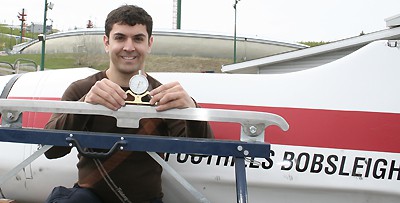
By Hamish Johnston
Much of Britain is under a thick blanket of snow – and there is even a light sprinkling of the stuff here in normally balmy Bristol. So it’s not surprising that our thoughts have turned to the physics of winter sports.
Louis Poirier is one physicist with both a practical and theoretical understanding of that subject. Poirier spent more than five years on Canada’s national bobsleigh team before starting a PhD in physics at the University of Calgary.
Poirier still has an academic interest in the sport and last year he published a paper in the journal Sports Engineering on “Optimization of handheld gauge sizes for rocker measurements of skate blades and bobsleigh runners”. That’s Louis pictured above with a gauge (photo courtesy of U of Calgary/Ken Bendiktsen).
Now, Poirier has turned his attention to making bobsleigh runs safer for athletes – an important issue for the sport after the death of a competitor in this year’s Winter Olympics. Tomorrow, Poirier will be at an international bobsleigh, skeleton and luge competition near Calgary armed with a radar gun.
Poirier told the Toronto Star that current models used to design tracks are not very accurate because they only consider the time the sled passes about six points along the run.
Using his radar data, Poirier hopes to work out the acceleration on the competitors as they whiz around bends in the track.
Interestingly, he says that speed isn’t always the problem – and that slow tracks can sometimes be more challenging (and dangerous) than faster ones.
Poirier hopes to be able to publish his findings but admits that it may be impossible to perform controlled measurements in a competitive event. You can read about his work here.



